新概念英语第一册44课
- 格式:ppt
- 大小:848.00 KB
- 文档页数:16
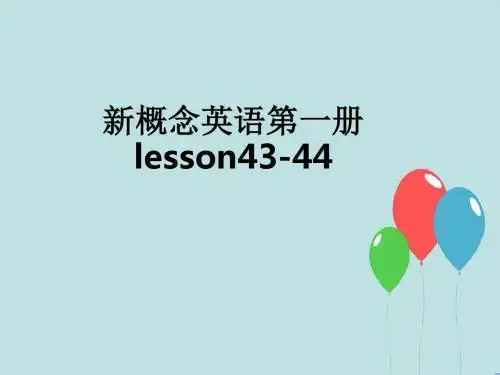
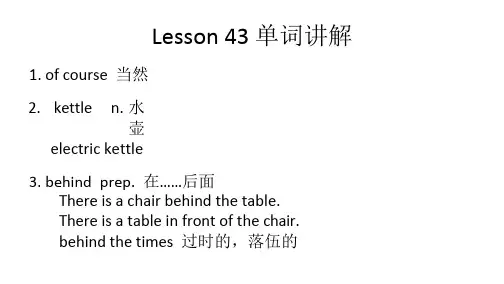
Lesson 43 单词讲解1.of course 当然2.kettle n. 水壶electric kettle3.behind prep. 在……后面There is a chair behind the table.There is a table in front of the chair.behind the times 过时的,落伍的Tom’s cell phone is behind the times.4.teapot n. 茶壶pot 锅,罐,容器hot pot 火锅flowerpot 花盆5.now adv. 现在,此刻--- What are you doing? --- I am cooking now. What are you going to do now?I am busy now.6.find v. 找到7.boil v. 沸腾,开The kettle is boiling.boil v. 煮Please boil me an egg. Please boil an egg for me. oil 油(汽油,食用油) oil painting 油画Lesson 43 课文讲解some & anysome adj. & pron. 一些,若干There is some beer in the bottle.Would you like some?any adj. & pron. 若干,任何Is there any beer in the bottle?No, there isn’t any.There are some books on the table. Are there any books on the table? There aren’t any books on the table. There is some water in the teapot. Is there any water in the teapot? There isn’t any water in the teapot. There are some boys in the room. Are there any boys in the room? There aren’t any boys in the room.如果是一个表示请求、建议、反问的疑问句,或希望得到对方肯定答案才提出的疑问句中可以用some.Shall I have some coffee?What about some tea?Why don’t we have some beer?Are there some students in the classroom?在一个表示部分否定的否定句中可以用some.Some of them are not Chinese.hurry v. 匆忙up adv. & prep. 向上,在高处get uphurry up (quickly)eat upspeed upspeak up (speak loudly) shut upwait up slow downcalm down come down here sit downput that downLesson 43 语法讲解情态动词canmustHe must go now.Must he go now? He needn’t go now. What must he do? We must study English.Must we study English? We needn’t study English. What must we do?She must be in the office.Must she be in the office? She mustn’t be in the office. Where must she be?I can help you.I can’t help you.Can I help you? Who can help you? She can swim.She can’t swim.Can she swim? Who can swim?I can see some clouds in the sky.I can’t see any clouds in the sky. Can you see any clouds in the sky? What can you see in the sky?Can you bring me some water, please? Can I have some water, please?Can I help you?Can I have your name?Can I have your phone number?Can I have your e-mail address?Can I use your bike?Can I have your order?Can I speak to Tom, please?Can I have a look at your cell phone?Can I have the key to the front door, please?Can1.能力Can you swim? I believe I can fly.Can you speak English?Do you speak English?2.允许(征求对方的意见)Can I come in? Can I smoke here?3.请求,要求Can you open the window, please? Can you shut up?Lesson 44 单词句型讲解some & any + 可数名词复数或不可数名词I can write some English letters (字母letter), but I can’t read any English _wo_r_d_s. (单词word)I can make some _tea (茶), but I can’t make any _c_offee. (咖啡)I can eat some _e_g gs_ (鸡蛋),but I can’t drink any bee_r. (啤酒)Lesson 43&44 知识拓展(学生版)1.(2008 北京) ---- you speak Japanese?---- No, I can’t.A. CanB. MustC. MayD. Should2.(2008 海南) ---- Ann, you say this word in Chinese?---- Yes, it’s easy.A. mayB. canC. mus。
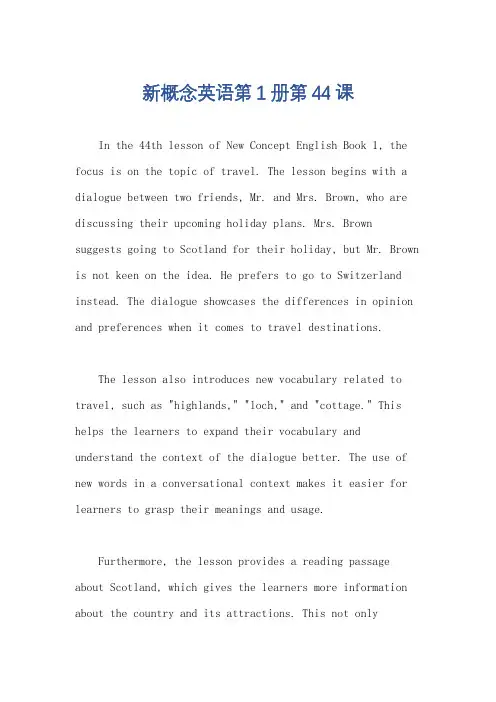
新概念英语第1册第44课In the 44th lesson of New Concept English Book 1, the focus is on the topic of travel. The lesson begins with a dialogue between two friends, Mr. and Mrs. Brown, who are discussing their upcoming holiday plans. Mrs. Brown suggests going to Scotland for their holiday, but Mr. Brown is not keen on the idea. He prefers to go to Switzerland instead. The dialogue showcases the differences in opinion and preferences when it comes to travel destinations.The lesson also introduces new vocabulary related to travel, such as "highlands," "loch," and "cottage." This helps the learners to expand their vocabulary and understand the context of the dialogue better. The use of new words in a conversational context makes it easier for learners to grasp their meanings and usage.Furthermore, the lesson provides a reading passage about Scotland, which gives the learners more information about the country and its attractions. This not onlyimproves their reading comprehension but also broadenstheir knowledge about different travel destinations. It encourages learners to explore and learn about new places, fostering a sense of curiosity and adventure.In addition to vocabulary and reading comprehension, the lesson also focuses on grammar. It introduces the past continuous tense through the dialogue between Mr. and Mrs. Brown. This tense is used to talk about actions that were happening at a specific time in the past. By incorporating grammar lessons into the context of travel, the lesson makes learning more practical and applicable to real-life situations.From a cultural perspective, the lesson providesinsight into the different travel preferences and interests of people. Mr. Brown's desire to go to Switzerland instead of Scotland reflects how individuals have diverse tastes when it comes to travel. It also highlights the importance of compromise and communication when making holiday plans with others.Moreover, the lesson encourages learners to appreciate the beauty of nature and explore different landscapes. The description of Scotland's highlands and lochs paints avivid picture of the country's natural beauty, inspiring learners to consider visiting such scenic destinations. It instills a sense of appreciation for the environment and the world around us.Overall, the 44th lesson of New Concept English Book 1 not only teaches language skills but also promotes cultural awareness, curiosity, and a sense of adventure. It equips learners with the necessary vocabulary, grammar, and reading comprehension skills while also broadening their understanding of different travel destinations and preferences. This holistic approach to language learning makes the lesson engaging and enriching for learners of English as a second language.。

⼀、重要句型或语法 1、情态动词:can 本⾝有⼀定的词义,表⽰语⽓的单词。
但是不能独⽴作谓语,只能和动词原形⼀起构成谓语。
情态动词⽤在⾏为动词前,表⽰说话⼈对这⼀动作或状态的看法或主观设想,如:He can dance./ He can't dance./ Can he dance? Yes, he can. 2、some与any的⽤法:与there be的连⽤ Is there any bread here? Yes, there is. There's some on the table. ⼆、课⽂主要语⾔点 Can you make the tea? make的⽤法可以做回顾拓展,如:make a cake, make coffee, make tea, make the bed等。
Yes, of course I can, Penny. of course相当于第41课中的certainly,表⽰“当然,肯定”。
Is there any water in this kettle? 注意kettle(⽔壶,⽤于烧⽔)和下⽂出现的teapot(茶壶,⽤于泡茶)的区别。
可从合成法⾓度解释teapot,因为它是由tea+pot构成的。
It's over there, behind the teapot. over there表⽰“在那边”,⽤来表⽰离说话者较远的地⽅。
如果较近,可以说“It's right here.”。
behind,可以对⽐复习⼀下in front of和in the front of。
There it is! 表⽰“就在那⼉”,⽤来指出远处的事物。
如果要近指,应该⽤:Here it is! 两者的复数形式分别为:There they are! / Here they are! Can you find them? 注意区分find和look for。
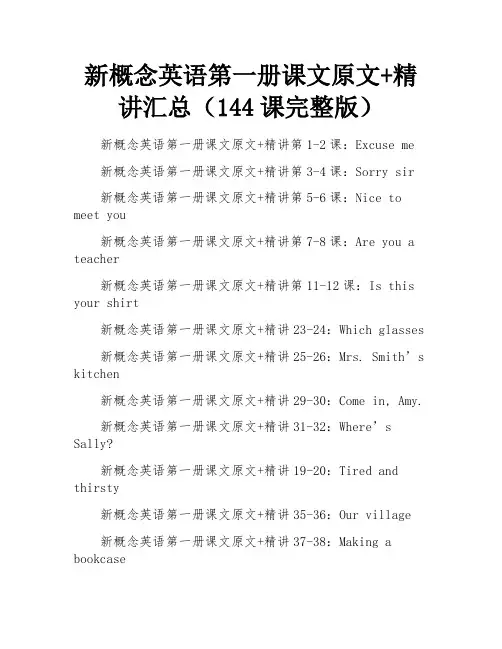
新概念英语第一册课文原文+精讲汇总(144课完整版)新概念英语第一册课文原文+精讲第1-2课:Excuse me新概念英语第一册课文原文+精讲第3-4课:Sorry sir新概念英语第一册课文原文+精讲第5-6课:Nice to meet you新概念英语第一册课文原文+精讲第7-8课:Are you a teacher新概念英语第一册课文原文+精讲第11-12课:Is this your shirt新概念英语第一册课文原文+精讲23-24:Which glasses新概念英语第一册课文原文+精讲25-26:Mrs. Smith’s kitchen新概念英语第一册课文原文+精讲29-30:Come in, Amy.新概念英语第一册课文原文+精讲31-32:Where’s Sally?新概念英语第一册课文原文+精讲19-20:Tired and thirsty新概念英语第一册课文原文+精讲35-36:Our village新概念英语第一册课文原文+精讲37-38:Making a bookcaseit!新概念英语第一册课文原文+精讲41-42:Penny’s bag新概念英语第一册课文原文+精讲33-34:A fine day新概念英语第一册课文原文+精讲43-44:Hurry up新概念英语第一册课文原文+精讲45-46:The boss’s letter新概念英语第一册课文原文+精讲47-48:A cup of coffee新概念英语第一册课文原文+精讲53-54:An interesting climate新概念英语第一册课文原文+精讲55-56:The Sawyer family新概念英语第一册课文原文+精讲57-58:An unusual day新概念英语第一册课文原文+精讲59-60:Is that all新概念英语第一册课文原文+精讲61-62:A bad cold新概念英语第一册课文原文+精讲63-64:Thank you , doctor新概念英语第一册课文原文+精讲67-68:The weekend新概念英语第一册课文原文+精讲69-70:The car race新概念英语第一册课文原文+精讲71-72:He’s awfulKing Street新概念英语第一册课文原文+精讲75-76:Unfortable shoes新概念英语第一册课文原文+精讲77-78:Terrible toothache新概念英语第一册课文原文+精讲81-82:Roast beef and potato新概念英语第一册课文原文+精讲83-84:Going on a holiday新概念英语第一册课文原文+精讲85课:Paris in the Spring新概念英语第一册课文原文+精讲87课:A car crash新概念英语第一册课文原文+精讲89课:For sale新概念英语第一册课文原文+精讲91课:Poor Ian新概念英语第一册课文原文+精讲93课:Our new neighbor新概念英语第一册课文原文+精讲95课:Ticket, please.新概念英语第一册课文原文+精讲97课:A small blue case新概念英语第一册课文原文+精讲99课:Ow!新概念英语第一册课文原文+精讲101课:A card from Jimmytest新概念英语第一册课文原文+精讲105课:Full of mistakes新概念英语第一册课文原文+精讲107课:It’s too small新概念英语第一册课文原文+精讲109课:A good idea新概念英语第一册课文原文+精讲111课:The most expensive model新概念英语第一册课文原文+精讲113课:small change新概念英语第一册课文原文+精讲115课:Knock,knock新概念英语第一册课文原文+精讲117课:Tommy’s breakfast新概念英语第一册课文原文+精讲119课: A true story新概念英语第一册课文原文+精讲121课: The man in the hat新概念英语第一册课文原文+精讲123课: A trip to Australia新概念英语第一册课文原文+精讲125课: Tea for two新概念英语第一册课文原文+精讲127课: A famous actress新概念英语第一册课文原文+精讲129课: 70 miles an hour新概念英语第一册课文原文+精讲133课: Sensational news新概念英语第一册课文原文+精讲135课:The latest新概念英语第一册课文原文+精讲139课:Is that you新概念英语第一册课文原文+精讲第141课:Sally’s first新概念英语第一册课文原文+精讲131课:Don’t be so sure。
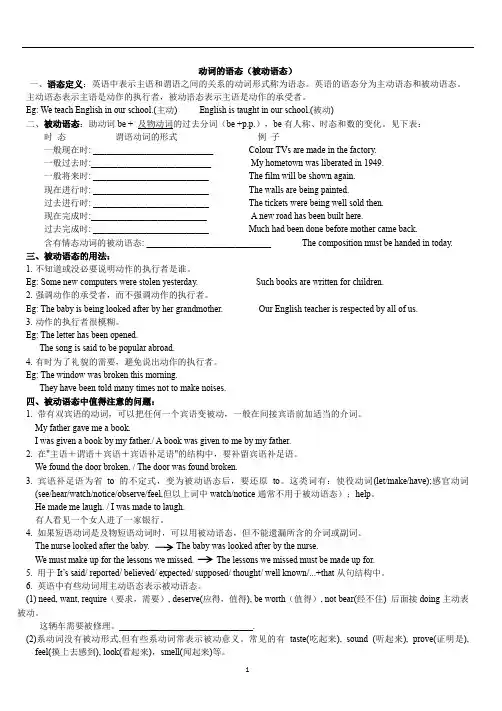
动词的语态(被动语态)一、语态定义:英语中表示主语和谓语之间的关系的动词形式称为语态。
英语的语态分为主动语态和被动语态。
主动语态表示主语是动作的执行者,被动语态表示主语是动作的承受者。
Eg: We teach English in our school.(主动) English is taught in our school.(被动)二、被动语态:助动词be + 及物动词的过去分词(be +p.p.),be有人称、时态和数的变化。
见下表:时态谓语动词的形式例子一般现在时: ___________________________ Colour TVs are made in the factory.一般过去时:___________________________ My hometown was liberated in 1949.一般将来时: __________________________ The film will be shown again.现在进行时: __________________________ The walls are being painted.过去进行时: __________________________ The tickets were being well sold then.现在完成时:__________________________ A new road has been built here.过去完成时: __________________________ Much had been done before mother came back.含有情态动词的被动语态: ____________________________ The composition must be handed in today.三、被动语态的用法:1.不知道或没必要说明动作的执行者是谁。
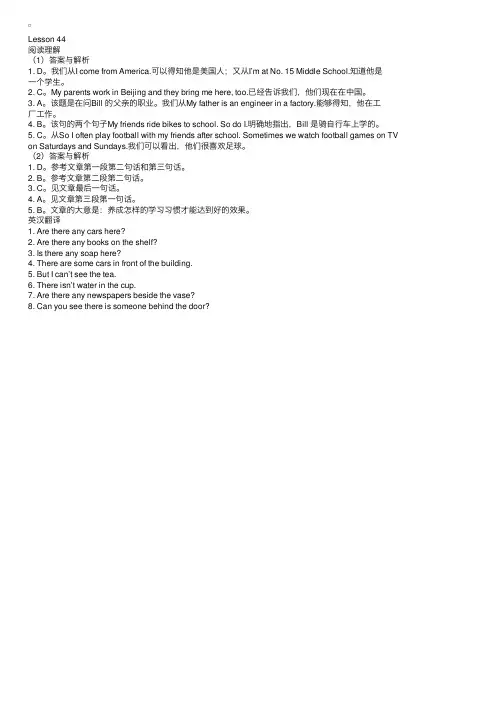
Lesson 44阅读理解(1)答案与解析1. D。
我们从I come from America.可以得知他是美国⼈;⼜从I’m at No. 15 Middle School.知道他是⼀个学⽣。
2. C。
My parents work in Beijing and they bring me here, too.已经告诉我们,他们现在在中国。
3. A。
该题是在问Bill 的⽗亲的职业。
我们从My father is an engineer in a factory.能够得知,他在⼯⼚⼯作。
4. B。
该句的两个句⼦My friends ride bikes to school. So do I.明确地指出,Bill 是骑⾃⾏车上学的。
5. C。
从So I often play football with my friends after school. Sometimes we watch football games on TV on Saturdays and Sundays.我们可以看出,他们很喜欢⾜球。
(2)答案与解析1. D。
参考⽂章第⼀段第⼆句话和第三句话。
2. B。
参考⽂章第⼆段第⼆句话。
3. C。
见⽂章最后⼀句话。
4. A。
见⽂章第三段第⼀句话。
5. B。
⽂章的⼤意是:养成怎样的学习习惯才能达到好的效果。
英汉翻译1. Are there any cars here?2. Are there any books on the shelf?3. Is there any soap here?4. There are some cars in front of the building.5. But I can’t see the tea.6. There isn’t water in the cup.7. Are there any newspapers beside the vase?8. Can you see there is someone behind the door?。
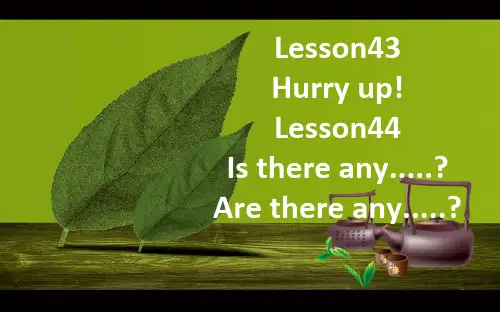
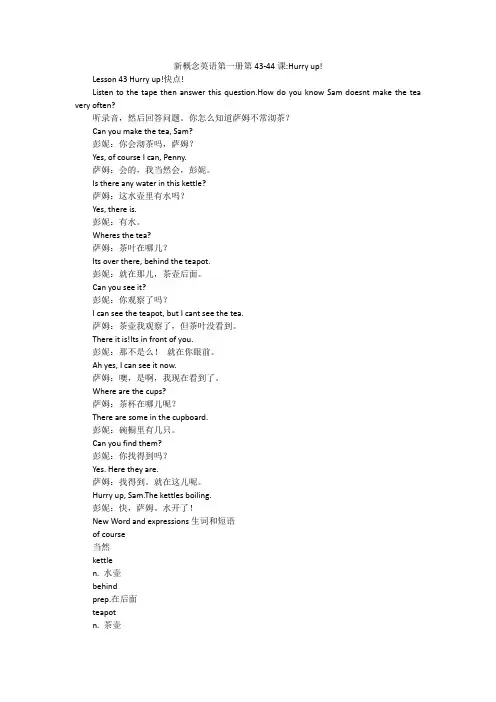
新概念英语第一册第43-44课:Hurry up!Lesson 43 Hurry up!快点!Listen to the tape then answer this question.How do you know Sam doesnt make the tea very often?听录音,然后回答问题。
你怎么知道萨姆不常沏茶?Can you make the tea, Sam?彭妮:你会沏茶吗,萨姆?Yes, of course I can, Penny.萨姆:会的,我当然会,彭妮。
Is there any water in this kettle?萨姆:这水壶里有水吗?Yes, there is.彭妮:有水。
Wheres the tea?萨姆:茶叶在哪儿?Its over there, behind the teapot.彭妮:就在那儿,茶壶后面。
Can you see it?彭妮:你观察了吗?I can see the teapot, but I cant see the tea.萨姆:茶壶我观察了,但茶叶没看到。
There it is!Its in front of you.彭妮:那不是么!就在你眼前。
Ah yes, I can see it now.萨姆:噢,是啊,我现在看到了。
Where are the cups?萨姆:茶杯在哪儿呢?There are some in the cupboard.彭妮:碗橱里有几只。
Can you find them?彭妮:你找得到吗?Yes. Here they are.萨姆:找得到。
就在这儿呢。
Hurry up, Sam.The kettles boiling.彭妮:快,萨姆。
水开了!New Word and expressions生词和短语of course当然kettlen. 水壶behindprep.在后面teapotn. 茶壶nowadv. 现在,此刻findv. 找到boilv. 沸腾,开Notes on the text课文解释1 make the tea 沏茶。
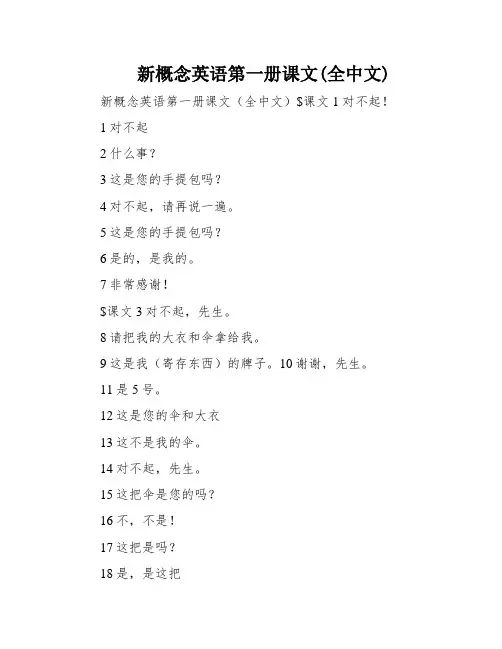
新概念英语第一册课文(全中文)新概念英语第一册课文(全中文)$课文1对不起!1对不起2什么事?3这是您的手提包吗?4对不起,请再说一遍。
5这是您的手提包吗?6是的,是我的。
7非常感谢!$课文3对不起,先生。
8请把我的大衣和伞拿给我。
9这是我(寄存东西)的牌子。
10谢谢,先生。
11是5号。
12这是您的伞和大衣13这不是我的伞。
14对不起,先生。
15这把伞是您的吗?16不,不是!17这把是吗?18是,是这把19非常感谢。
$课文5很高兴见到你。
20早上好。
21早上好,XXX先生。
22这位是XXX23XXX是个新学生。
24她是法国人。
25XXX,这位是XXX。
26他是德国人。
27很兴奋见到你。
28这位是直子。
29她是日本人。
30很高兴见到你。
31这位是XXX。
32他是韩国人。
33很高兴见到你。
34这位是XXX。
35他是中国人。
36很兴奋见到你。
37这位是XXX。
38她也是中国人。
39很兴奋见到你。
$课文7你是教师吗?40我是个新学生。
41我的名字叫XXX。
42很高兴见到你。
43我的名字叫XXX。
44你是法国人吗?45是的,我是法国人。
46你也是法国人吗?47不,我不是。
48你是哪国人?49我是意大利人。
50你是教师吗?51不,我不是。
52你是做甚么事情的?53我是电脑录入员。
54你是做什么工作的?55我是工程师。
$课文9今天好吗?56你好,XXX57你好,XXX58你今天好吗?59很好,谢谢你。
60你好吗?61很好,感谢。
62XXX好吗?63他很好,感谢。
XXX好吗?65她也很好,XXX。
66再会,XXX。
67见到你真高兴。
68我见到你也很兴奋,XXX再会。
$课文11这是你的衬衫吗?70那是谁的衬衫?71戴夫,这是你的衬衫吗?72不,先生。
73这不是我的衬衫。
74这是我的衬衫。
75我的衬衫是蓝色的。
76这件衬衫是XXX的吗?77也许是,先生。
78XXX的衬衫是白色的。
79XXX!80甚么事,师长教师。
81这是你的衬衫吗?82是的,先生。
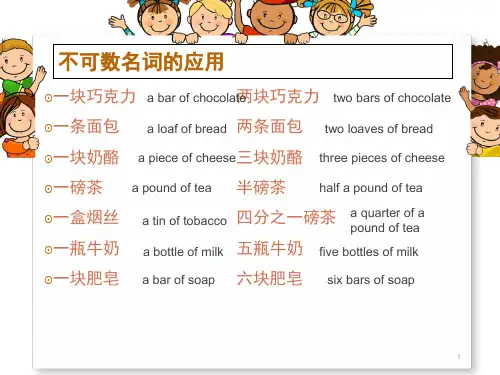
新概念英语第一册第43-44课:Hurry up!Lesson 43 Hurry up!快点!Listen to the tape then answer this question.How do you know Sam doesn't make the tea very often?听录音,然后回答问题。
你怎么知道萨姆不常沏茶?Can you make the tea, Sam?彭妮:你会沏茶吗,萨姆?Yes, of course I can, Penny.萨姆:会的,我当然会,彭妮。
Is there any water in this kettle?萨姆:这水壶里有水吗?Yes, there is.彭妮:有水。
Where’s the tea?萨姆:茶叶在哪儿?It’s over there, behind the teapot.彭妮:就在那儿,茶壶后面。
Can you see it?彭妮:你看见了吗?I can see the teapot, but I can’t see the tea.萨姆:茶壶我看见了,但茶叶没看到。
There it is!It’s in front of you. 彭妮:那不是么!就在你眼前。
Ah yes, I can see it now.萨姆:噢,是啊,我现在看到了。
Where are the cups?萨姆:茶杯在哪儿呢?There are some in the cupboard.彭妮:碗橱里有几只。
Can you find them?彭妮:你找得到吗?Yes. Here they are.萨姆:找得到。
就在这儿呢。
Hurry up, Sam.The kettle’s boiling. 彭妮:快,萨姆。
水开了!New Word and expressions生词和短语of course当然kettlen. 水壶behindprep.在……后面teapotn. 茶壶nowadv. 现在,此刻findv. 找到boilv. 沸腾,开Notes on the text课文注释1 make the tea 沏茶。
新概念一44课单词新概念英语第一册第44课的单词包括:
1. apply.
2. application.
3. suitable.
4. unsuitable.
5. employ.
6. employer.
7. employee.
8. employment.
9. unemployed.
10. qualification.
11. graduate.
12. skilled.
13. unskilled.
14. experience.
15. reference.
这些单词涵盖了与求职、雇佣和工作相关的词汇,是在学习英语的过程中非常重要的词汇。
在这一课中,学习者将会了解到与求职和工作相关的词汇,并学习如何正确地运用这些词汇进行交流和表达。
这些单词可以帮助学习者扩展词汇量,提高英语表达能力,并且在实际生活中应用到求职和工作中去。
通过学习这些单词,学习者可以更好地理解和运用与职业生涯相关的英语词汇,为未来的求职和工作做好准备。
同时,这些单词也是扎实英语基础的重要组成部分,对于提高英语水平和应对各种语言环境都具有重要意义。
希望这些单词能够帮助你更好地学习和掌握英语。